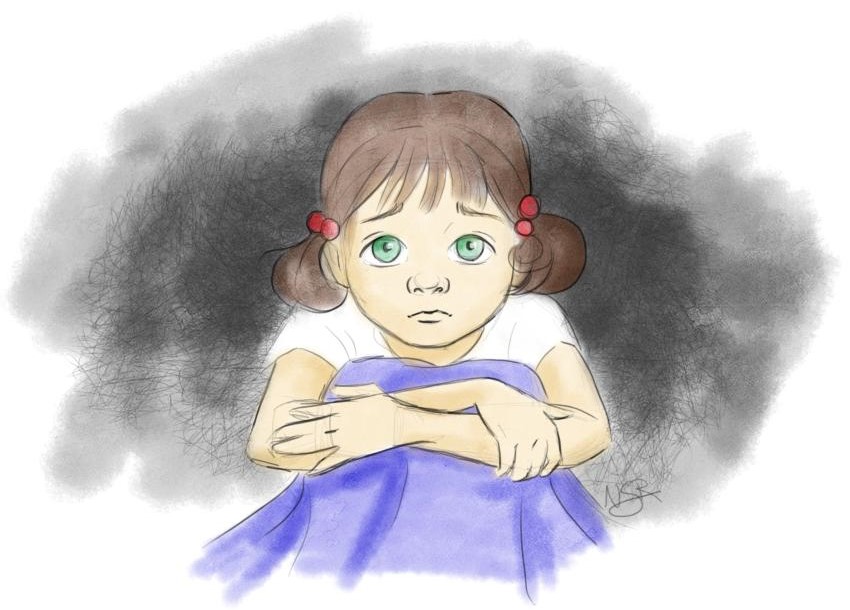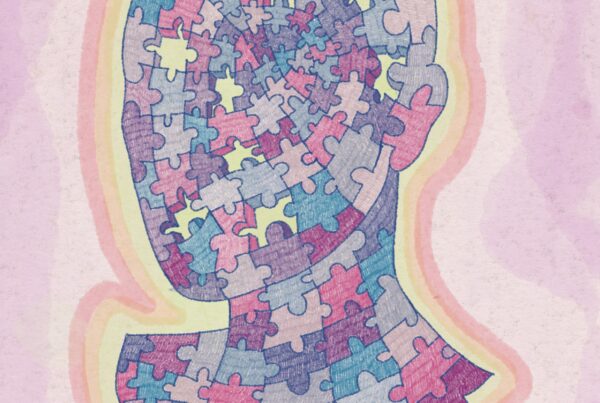
Growing up is not easy, and children can experience anxiety during the many challenges they face. Making friends, going to school or participating in household activities can be exciting but also trigger many worries. Researchers have various ideas on how to reduce such worries and their negative effects on the behaviour of children.
Growing up is not easy, and children can experience anxiety during the many challenges they face. Making friends, going to school or participating in household activities can be exciting but also trigger many worries. Researchers have various ideas on how to reduce such worries and their negative effects on the behaviour of children.

Illustration by Nina Kollof

Illustration by Nina Kollof
A number of paths can be taken to reduce anxiety. One such path is to target the phenomena that sustain it, such as cognitive biases and avoidance. For example, children might have worries that stem from irrational beliefs they form about the world, like “only bad things can happen if I go there”, or “everyone will make fun of me if I do this” (these are the cognitive biases). They might also avoid the situations that scare them, such as going to the hairdresser or asking someone to play with them. Another path is to help children control their emotions and behavior while they experience anxiety, making the anxiety-provoking situation more manageable and easier to confront.
The majority of school-based interventions in children between 5 and 18 years old try to reduce anxiety by using one or a combination of strategies (Hugh-Jones et al., 2020). Apart from cognitive-behavioral therapy (CBT), which is the most common, interventions also involve play therapy, working memory training, mindfulness, or biofeedback (Hugh-Jones et al., 2020). The meta-analysis done by Hugh-Jones et al. (2020) revealed that such school interventions reduce anxiety in children just a little bit, but that this reduction can last up to one year. Furthermore, it showed that it is better if the interventions are delivered by teachers who know the children and not by mental health professionals from outside the school. Understandably so, since they have a deeper connection with the children.
Like school interventions, at-home interventions by parents also employ CBT techniques. For instance, there are interventions that train parents to guide their children’s thinking or to gradually expose them to manageable anxiety-provoking situations (Rapee et al., 2010). In addition to these, other interventions advocate for a clear and consistent parenting style so that parents themselves don’t contribute to the development of dysfunctional cognitive schemas (Cartwright-Hatton et al, 2011). Importantly, it is not enough for the parents to have one training – they should be trained regularly because it was observed that the effects of one-time interventions decrease with time (Cartwright-Hatton et al., 2011).
“The reviewed studies paint an optimistic picture regarding the management of anxiety in children.”
Two other types of interventions have been often investigated: physical exercise and mindfulness. The idea behind physical exercise interventions is that they can lead to a reduction in tension, a focus on the present moment, or an exposure to feared bodily symptoms without negative consequences (for example increased heart rate) that would reduce anxiety (Holzel et al., 2013, Parker et al., 2018, Petruzzello et al., 1991, cited in Carter et al., 2021). The idea behind mindfulness interventions is that they can reduce anxiety by stopping the cycle of automatic negative thoughts or by helping children shift attention from maladaptive to healthy cognitions faster (Baer, 2003; Shapiro et al., 2006, cited in Odgers, 2020).
With the evidence available now, it is difficult to determine whether one exercise is better than the other because meta-analyses looked at a broad range of them, from yoga to aerobics, done in groups or individually. Moreover, it is hard to say something about physical exercise interventions alone because they are usually done together with CBT elements, but they seem to have a moderate effect on anxiety (Carter et al., 2021). Still, this effect is temporary, so these interventions have the disadvantage of having to be done repeatedly. Nevertheless, they are not expensive and they are easy to implement especially in schools, for groups of children. Moreover, they also have physical health benefits.
Regarding mindfulness, two meta-analyses concluded that its effect on children’s and adolescents’ anxiety are likely too small to have a practical impact, after only finding small or non-significant results (Odgers et al., 2020; Ruiz‐Íñiguez et al., 2020). Interestingly, Odgers et al. (2020) found that location moderated the effect such that the effect of mindfulness on children’s anxiety was highest in Iran, while participants in Western countries showed no effect of mindfulness in reducing anxiety. It is not yet clear why this difference exists, but it is known that the effects of mindfulness increase with how much practice someone has with it (Slagter et al., 2007). It might be the case that people from particular cultures are more acquainted with mindfulness either because it is commonly practiced in their community or because they engage in similar activities such as prayer. Future research could investigate this possibility and confirm whether the effectiveness of mindfulness remains robust in particular countries.
To conclude, the reviewed studies paint an optimistic picture regarding the management of anxiety in children. Both school-based and parenting-based interventions that rely on CBT seem to have a small to moderate effect in reducing anxiety in children. Such interventions teach children to control maladaptive thoughts and replace them with healthier alternatives or have parents and teachers expose them to feared situations gradually. Research suggests that anxious children fare better if instructions from teachers and parents are positive, clear, and consistent. These interventions have the potential to last up to a few years, but retraining parents and teachers regularly could lead to longer-lasting effects. Apart from CBT, physical exercise can also help reduce anxiety. However, mindfulness interventions do not offer the expected results.
Noticing and alleviating children’s anxiety is something caretakers and educators should always have in the back of their minds. For children who leave in very stressful situations, such as armed conflicts and economic instability, addressing anxiety is crucial to how these adverse events will impact them throughout their upbringing. <<
References
-
Blöte, A. W., Miers, A. C., & Westenberg, P. M. (2015). The Role of Social Performance and Physical Attractiveness in Peer Rejection of Socially Anxious Adolescents. Journal of Research on Adolescence, 25(1), 189–200. https://doi.org/10.1111/jora.12107
-
Carter, T., Pascoe, M., Bastounis, A., Morres, I. D., Callaghan, P., & Parker, A. G. (2021). The effect of physical activity on anxiety in children and young people: A systematic review and meta-analysis. Journal of Affective Disorders, 285, 10–21. https://doi.org/10.1016/j.jad.2021.02.026
-
Cartwright-Hatton, S., McNally, D., Field, A. P., Rust, S., Laskey, B., Dixon, C., Gallagher, B., Harrington, R., Miller, C., Pemberton, K., Symes, W., White, C., & Woodham, A. (2011). A New Parenting-Based Group Intervention for Young Anxious Children: Results of a Randomized Controlled Trial. Journal of the American Academy of Child & Adolescent Psychiatry, 50(3), 242-251.e6. https://doi.org/10.1016/j.jaac.2010.12.015
-
Castagna, P. J., Calamia, M., & Davis III, T. E. (2021). Can worry and physiological anxiety uniquely predict children and adolescents’ academic achievement and intelligence? Applied Neuropsychology: Child, 10(1), 53–64. https://doi.org/10.1080/21622965.2019.1596809
-
Hugh-Jones, S., Beckett, S., Tumelty, E., & Mallikarjun, P. (2021). Indicated prevention interventions for anxiety in children and adolescents: A review and meta-analysis of school-based programs. European Child & Adolescent Psychiatry, 30(6), 849–860. https://doi.org/10.1007/s00787-020-01564-x
-
Hughes, A. A., Lourea-Waddell, B., & Kendall, P. C. (2008). Somatic Complaints in Children with Anxiety Disorders and their Unique Prediction of Poorer Academic Performance. Child Psychiatry and Human Development, 39(2), 211–220. https://doi.org/10.1007/s10578-007-0082-5
-
Jansen, Brenda. “Lecture 2 CCSP Anxiety”, Canvas, 17 February 2022, University of Amsterdam.
-
Odgers, K., Dargue, N., Creswell, C., Jones, M. P., & Hudson, J. L. (2020). The Limited Effect of Mindfulness-Based Interventions on Anxiety in Children and Adolescents: A Meta-Analysis. Clinical Child and Family Psychology Review, 23(3), 407–426. https://doi.org/10.1007/s10567-020-00319-z
-
Rapee, R. M., Kennedy, S. J., Ingram, M., Edwards, S. L., & Sweeney, L. (2010). Altering the Trajectory of Anxiety in At-Risk Young Children. American Journal of Psychiatry, 167(12), 1518–1525. https://doi.org/10.1176/appi.ajp.2010.09111619
-
Ruiz Íñiguez, R., Santed Germán, M. Á., Burgos, Julián, F. A., Díaz, Silveira, C., & Carralero Montero, A. (2020). Effectiveness of mindfulness based interventions on anxiety for children and adolescents: A systematic review and meta analysis. Early Intervention in Psychiatry, 14(3), 263–274. https://doi.org/10.1111/eip.12849
-
Slagter, H. A., Lutz, A., Greischar, L. L., Francis, A. D., Nieuwenhuis, S., Davis, J. M., & Davidson, R. J. (2007). Mental Training Affects Distribution of Limited Brain Resources. PLoS Biology, 5(6), e138. https://doi.org/10.1371/journal.pbio.0050138
A number of paths can be taken to reduce anxiety. One such path is to target the phenomena that sustain it, such as cognitive biases and avoidance. For example, children might have worries that stem from irrational beliefs they form about the world, like “only bad things can happen if I go there”, or “everyone will make fun of me if I do this” (these are the cognitive biases). They might also avoid the situations that scare them, such as going to the hairdresser or asking someone to play with them. Another path is to help children control their emotions and behavior while they experience anxiety, making the anxiety-provoking situation more manageable and easier to confront.
The majority of school-based interventions in children between 5 and 18 years old try to reduce anxiety by using one or a combination of strategies (Hugh-Jones et al., 2020). Apart from cognitive-behavioral therapy (CBT), which is the most common, interventions also involve play therapy, working memory training, mindfulness, or biofeedback (Hugh-Jones et al., 2020). The meta-analysis done by Hugh-Jones et al. (2020) revealed that such school interventions reduce anxiety in children just a little bit, but that this reduction can last up to one year. Furthermore, it showed that it is better if the interventions are delivered by teachers who know the children and not by mental health professionals from outside the school. Understandably so, since they have a deeper connection with the children.
Like school interventions, at-home interventions by parents also employ CBT techniques. For instance, there are interventions that train parents to guide their children’s thinking or to gradually expose them to manageable anxiety-provoking situations (Rapee et al., 2010). In addition to these, other interventions advocate for a clear and consistent parenting style so that parents themselves don’t contribute to the development of dysfunctional cognitive schemas (Cartwright-Hatton et al, 2011). Importantly, it is not enough for the parents to have one training – they should be trained regularly because it was observed that the effects of one-time interventions decrease with time (Cartwright-Hatton et al., 2011).
“The reviewed studies paint an optimistic picture regarding the management of anxiety in children.”
Two other types of interventions have been often investigated: physical exercise and mindfulness. The idea behind physical exercise interventions is that they can lead to a reduction in tension, a focus on the present moment, or an exposure to feared bodily symptoms without negative consequences (for example increased heart rate) that would reduce anxiety (Holzel et al., 2013, Parker et al., 2018, Petruzzello et al., 1991, cited in Carter et al., 2021). The idea behind mindfulness interventions is that they can reduce anxiety by stopping the cycle of automatic negative thoughts or by helping children shift attention from maladaptive to healthy cognitions faster (Baer, 2003; Shapiro et al., 2006, cited in Odgers, 2020).
With the evidence available now, it is difficult to determine whether one exercise is better than the other because meta-analyses looked at a broad range of them, from yoga to aerobics, done in groups or individually. Moreover, it is hard to say something about physical exercise interventions alone because they are usually done together with CBT elements, but they seem to have a moderate effect on anxiety (Carter et al., 2021). Still, this effect is temporary, so these interventions have the disadvantage of having to be done repeatedly. Nevertheless, they are not expensive and they are easy to implement especially in schools, for groups of children. Moreover, they also have physical health benefits.
Regarding mindfulness, two meta-analyses concluded that its effect on children’s and adolescents’ anxiety are likely too small to have a practical impact, after only finding small or non-significant results (Odgers et al., 2020; Ruiz‐Íñiguez et al., 2020). Interestingly, Odgers et al. (2020) found that location moderated the effect such that the effect of mindfulness on children’s anxiety was highest in Iran, while participants in Western countries showed no effect of mindfulness in reducing anxiety. It is not yet clear why this difference exists, but it is known that the effects of mindfulness increase with how much practice someone has with it (Slagter et al., 2007). It might be the case that people from particular cultures are more acquainted with mindfulness either because it is commonly practiced in their community or because they engage in similar activities such as prayer. Future research could investigate this possibility and confirm whether the effectiveness of mindfulness remains robust in particular countries.
To conclude, the reviewed studies paint an optimistic picture regarding the management of anxiety in children. Both school-based and parenting-based interventions that rely on CBT seem to have a small to moderate effect in reducing anxiety in children. Such interventions teach children to control maladaptive thoughts and replace them with healthier alternatives or have parents and teachers expose them to feared situations gradually. Research suggests that anxious children fare better if instructions from teachers and parents are positive, clear, and consistent. These interventions have the potential to last up to a few years, but retraining parents and teachers regularly could lead to longer-lasting effects. Apart from CBT, physical exercise can also help reduce anxiety. However, mindfulness interventions do not offer the expected results.
Noticing and alleviating children’s anxiety is something caretakers and educators should always have in the back of their minds. For children who leave in very stressful situations, such as armed conflicts and economic instability, addressing anxiety is crucial to how these adverse events will impact them throughout their upbringing. <<
References
-
Blöte, A. W., Miers, A. C., & Westenberg, P. M. (2015). The Role of Social Performance and Physical Attractiveness in Peer Rejection of Socially Anxious Adolescents. Journal of Research on Adolescence, 25(1), 189–200. https://doi.org/10.1111/jora.12107
-
Carter, T., Pascoe, M., Bastounis, A., Morres, I. D., Callaghan, P., & Parker, A. G. (2021). The effect of physical activity on anxiety in children and young people: A systematic review and meta-analysis. Journal of Affective Disorders, 285, 10–21. https://doi.org/10.1016/j.jad.2021.02.026
-
Cartwright-Hatton, S., McNally, D., Field, A. P., Rust, S., Laskey, B., Dixon, C., Gallagher, B., Harrington, R., Miller, C., Pemberton, K., Symes, W., White, C., & Woodham, A. (2011). A New Parenting-Based Group Intervention for Young Anxious Children: Results of a Randomized Controlled Trial. Journal of the American Academy of Child & Adolescent Psychiatry, 50(3), 242-251.e6. https://doi.org/10.1016/j.jaac.2010.12.015
-
Castagna, P. J., Calamia, M., & Davis III, T. E. (2021). Can worry and physiological anxiety uniquely predict children and adolescents’ academic achievement and intelligence? Applied Neuropsychology: Child, 10(1), 53–64. https://doi.org/10.1080/21622965.2019.1596809
-
Hugh-Jones, S., Beckett, S., Tumelty, E., & Mallikarjun, P. (2021). Indicated prevention interventions for anxiety in children and adolescents: A review and meta-analysis of school-based programs. European Child & Adolescent Psychiatry, 30(6), 849–860. https://doi.org/10.1007/s00787-020-01564-x
-
Hughes, A. A., Lourea-Waddell, B., & Kendall, P. C. (2008). Somatic Complaints in Children with Anxiety Disorders and their Unique Prediction of Poorer Academic Performance. Child Psychiatry and Human Development, 39(2), 211–220. https://doi.org/10.1007/s10578-007-0082-5
-
Jansen, Brenda. “Lecture 2 CCSP Anxiety”, Canvas, 17 February 2022, University of Amsterdam.
-
Odgers, K., Dargue, N., Creswell, C., Jones, M. P., & Hudson, J. L. (2020). The Limited Effect of Mindfulness-Based Interventions on Anxiety in Children and Adolescents: A Meta-Analysis. Clinical Child and Family Psychology Review, 23(3), 407–426. https://doi.org/10.1007/s10567-020-00319-z
-
Rapee, R. M., Kennedy, S. J., Ingram, M., Edwards, S. L., & Sweeney, L. (2010). Altering the Trajectory of Anxiety in At-Risk Young Children. American Journal of Psychiatry, 167(12), 1518–1525. https://doi.org/10.1176/appi.ajp.2010.09111619
-
Ruiz Íñiguez, R., Santed Germán, M. Á., Burgos, Julián, F. A., Díaz, Silveira, C., & Carralero Montero, A. (2020). Effectiveness of mindfulness based interventions on anxiety for children and adolescents: A systematic review and meta analysis. Early Intervention in Psychiatry, 14(3), 263–274. https://doi.org/10.1111/eip.12849
-
Slagter, H. A., Lutz, A., Greischar, L. L., Francis, A. D., Nieuwenhuis, S., Davis, J. M., & Davidson, R. J. (2007). Mental Training Affects Distribution of Limited Brain Resources. PLoS Biology, 5(6), e138. https://doi.org/10.1371/journal.pbio.0050138


